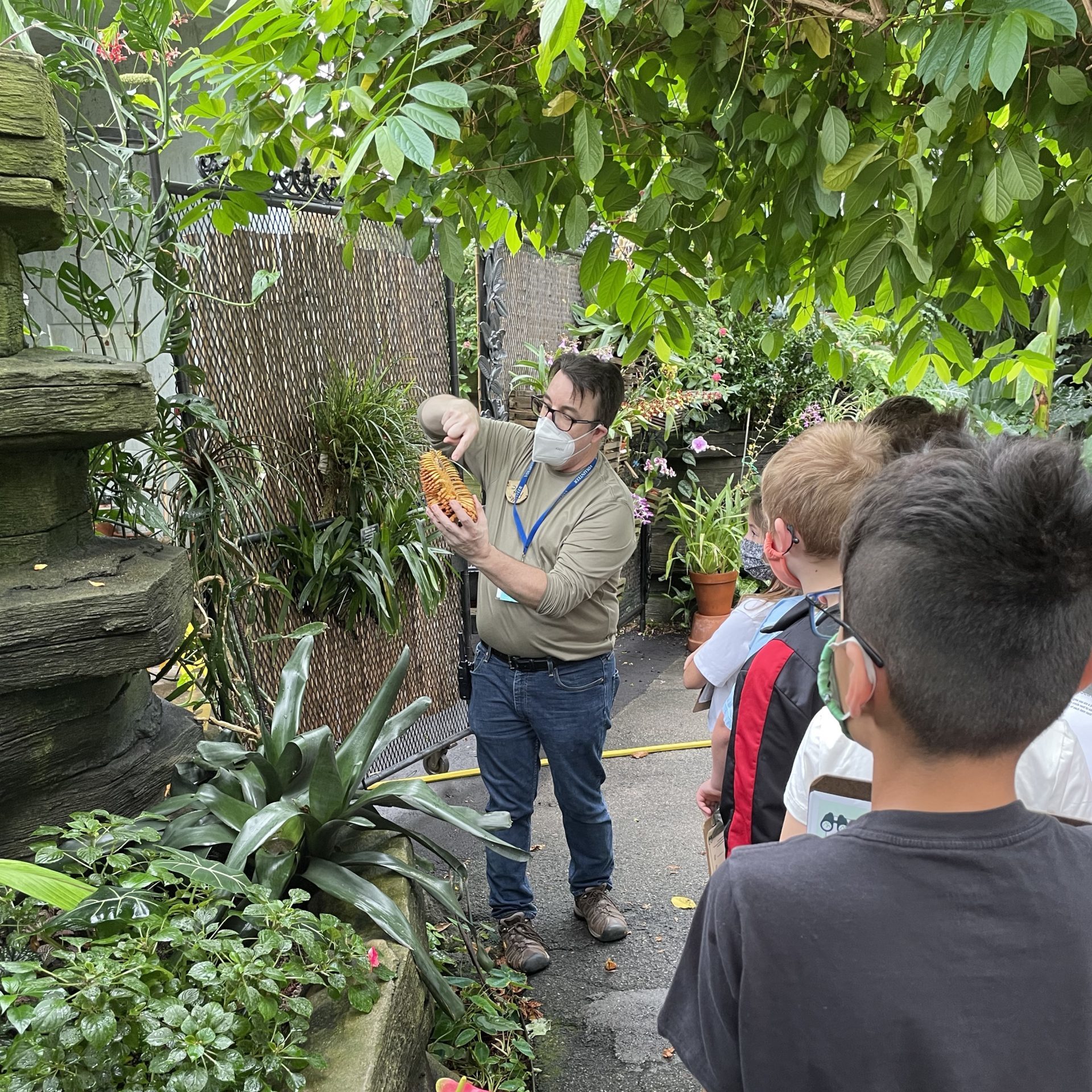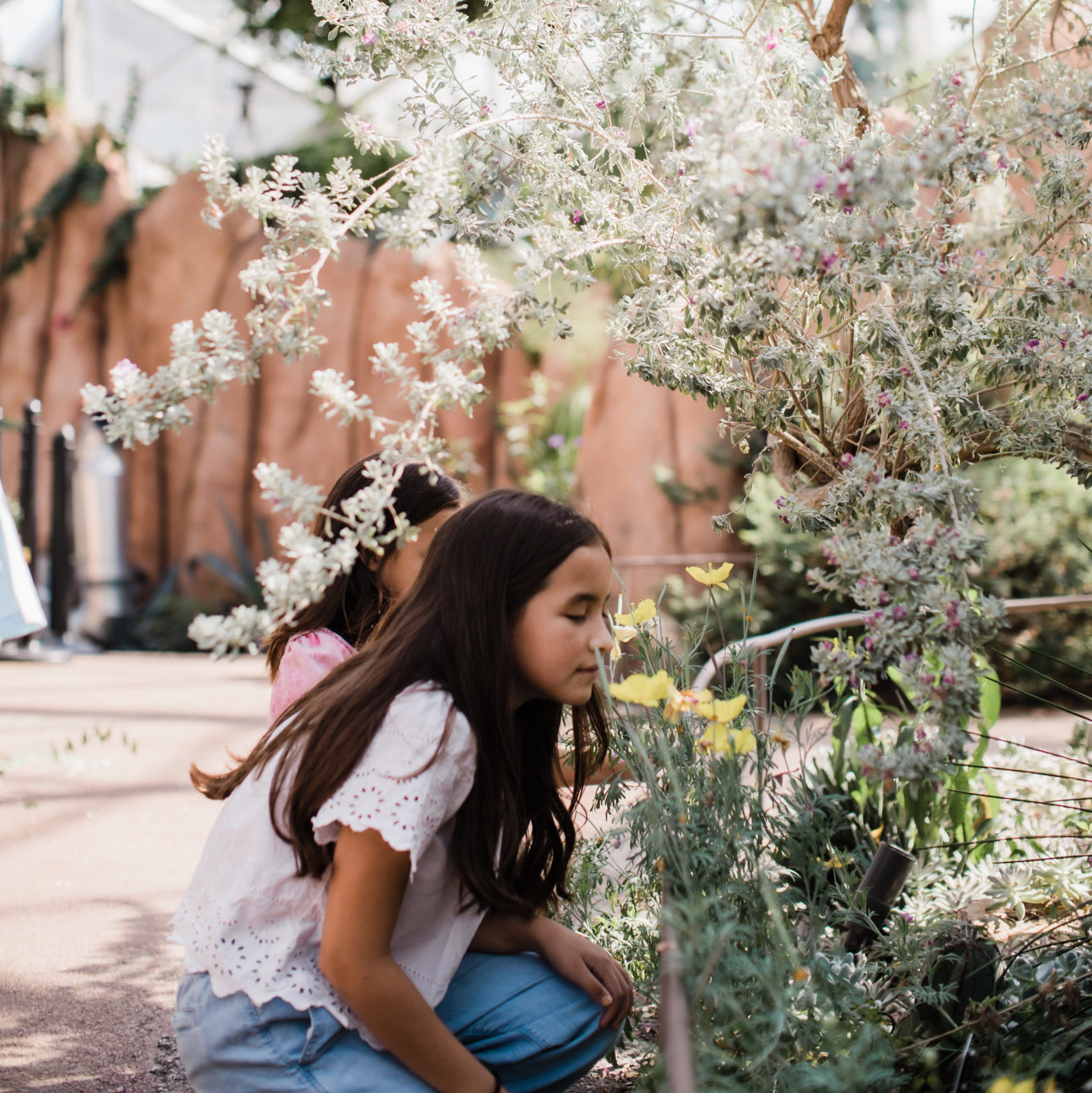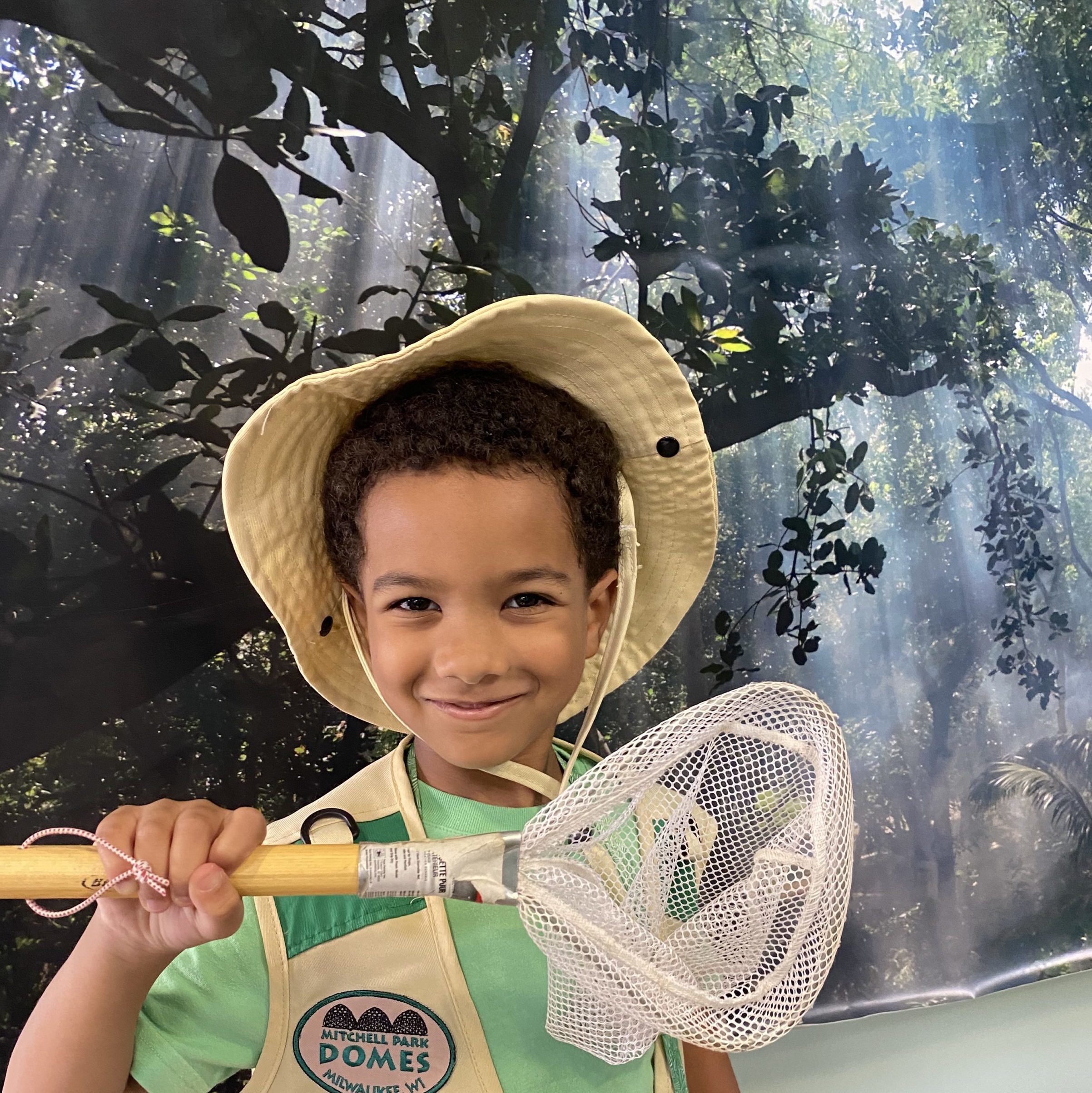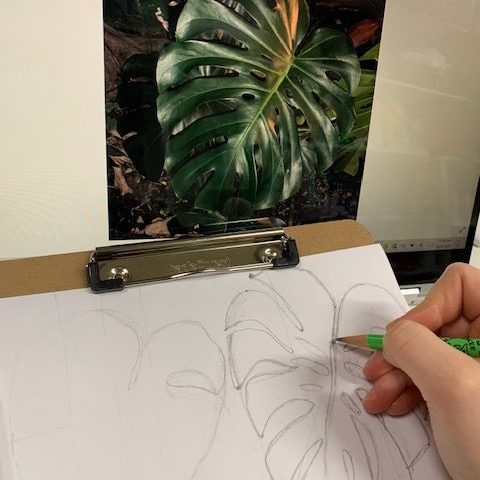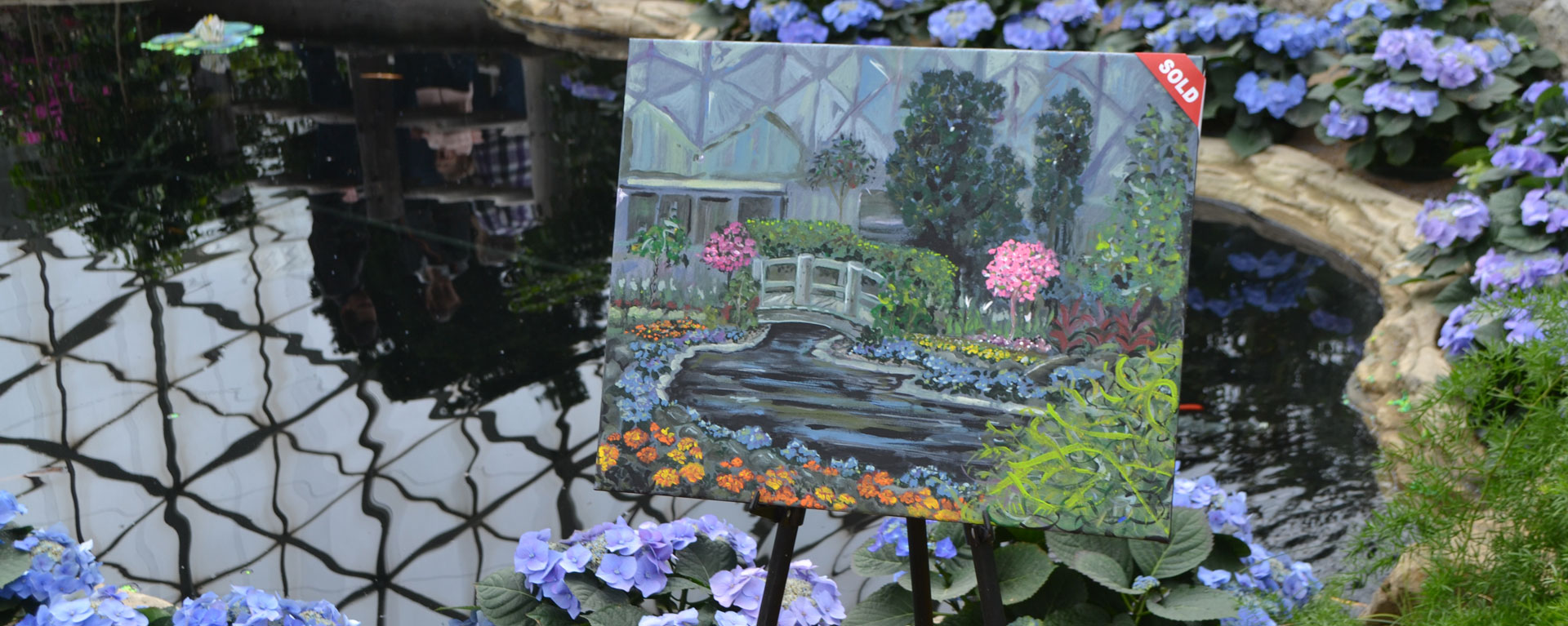Thank you for your interest in a Domes field trip! Our unique facility allows youth and teenagers to explore three unique ecosystems in the course of an afternoon!
We offer instructor-led field trips for students ages K5 through high school. Our engaging field trips are appropriate for schools, Scout organizations, after-school programs, home schools and any other youth-serving organization. Field trips are available year-round, Mondays, Wednesdays, Thursdays and Fridays.
Each in-person program lasts 1.5-2 hours, and provides students with the opportunity to acquire nature-based knowledge, experiences, hobbies and values. Students participate in a hands-on, educator-led experience and have the opportunity to experience all three Domes. Please note that field trips scheduled during Show Dome transitions will only be able to visit two domes (Desert and Tropical). To check the Show Dome schedule, click here.
All Programs Include:
- A large group introduction;
- Small group exploration of The Domes (3 groups rotate through each dome);
- A program in one dome (four options listed below);
- A large group conclusion;
- Optional pre/post learning opportunities.
Fees for Guided In-Person Field Trips
- $8 per person (includes youth and chaperones)
- Minimum of 15 participants (students + adults), or $120, per guided, in-person field trip
- Maximum of 70 participants (students + adults). Larger groups will be split into separate days or times.
- $50 cancellation fee if program is cancelled less than two weeks before start date
- $120 cancellation fee if program is canceled less than five days before state date
- Programs canceled by the Friends do not incur a cancellation fee.
Note: The Friends of the Domes works to ensure that all groups have access to these wonderful learning opportunities. Scholarships are available. Indicate your interest in a scholarship when completing the field trip interest form.
Information About Chaperones
- One chaperone required for each 10 children (35 children = 3 chaperones)
- A maximum of 12 adult chaperones per field trip (exceptions for students with special needs)
- Chaperones include any and all adults attending with the group during the time of your field trip, including teachers, assistants, aides, parents, etc.
- Groups with young students or students with accessibility or special needs are recommended to have additional chaperones, although it is not required.
Other Important Information
- Field trips must be scheduled at least three weeks in advance.
- Final numbers and payment are required at least two weeks prior to the program start date.
Field Trip Add-Ons
My Trip to the Domes Coloring Book
- A 25 page activity booklet can be added for each student for an additional $0.75 per student.
Seed Starting Kit
- These kits contain everything you need to grow a plant from seed at home or at school. $2.50 per student.
If you have additional questions, contact the Education Director.
In-Person Field Trip Options
OPTION #1: POLLINATORS, UNITE! (K4-9th)
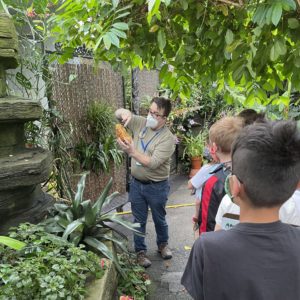
Special Focus: Tropical Dome
Many flowering plants all over the world depend on many pollinators to continue the plant’s life cycle.
Grade Levels: K4-Middle School (program adapted for grade level)
K4-6th Program Information
Description: Join Mr. Pete as he leads you in the game show “Who’s Your Pollinator?” Then he will take you on a tour of the Tropical Dome in search of some amazing plants that need those pollinators!
Topics: Structure and Function, Organization for Matter and Energy Flow in Organisms, Interdependent Relationships, Biodiversity
Applicable Standards
Pollinators, Unite! explores topics related to the following Wisconsin State Standards:
Life Science K-2
- SCI.LS1.A.1: Structure and Function: All organisms have external parts that they use to perform daily functions.
- SCI.LS1.C.K: Organization for Matter and Energy Flow in Organisms: Animals obtain food they need from plants or other animals. Plants need water and light.
- SCI.LS2.A.2: Interdependent Relationships in Ecosystems: Plants depend on water and light to grow. Plants depend on animals for pollination or to move their seeds around.
- SCI.LS4.D.2: Biodiversity and Humans: There are many different kinds of living things in any area, and they exist in different places on land and in water.
Life Science 3-5
- SCI.LS1.A.4: Structure and Function: Plants and animals have both internal and external macroscopic structures that allow for growth, survival, behavior, and reproduction.
- SCI.LS1.B.3: Growth and Development of Organisms: Reproduction is essential to every kind of organism. Organisms have unique and diverse life cycles.
- SCI.LS1.C.5: Organization for Matter and Energy Flow in Organisms: Food provides animals with the materials and energy they need for body repair, growth, warmth, and motion. Plants acquire material for growth chiefly from air, water, and process matter, and obtain energy from sunlight, which is used to maintain conditions necessary for survival.
- SCI.PS3.D.4, 5: Energy in Chemical Processes and Everyday Life: Plants capture energy from sunlight which can be used as fuel or food.
- Environmental Literacy and Sustainability
6th-9th Program Information
Description: Exploring the three environments of The Domes, we will investigate how an ecosystem depends on the interactions of biotic and abiotic components to determine its health. We will compare and contrast ecosystems, take a look at their parts, and discover how pollination interactions give us a closer look at cause and effect relationships.
Topics: Ecosystems, Biotic and Abiotic factors, Pollination, Observation, Structure and Function, Organization for Matter and Energy Flow in Organisms, Interdependent Relationships, Biodiversity, Environmental Literacy and Sustainability
Applicable Standards
Pollinators, Unite! explores topics related to the following Wisconsin State Standards:
Life Science MS
- SCI.LS1.C.m: Organization for Matter and Energy Flow in Organisms: Plants use the energy from light to make sugars through photosynthesis. Within individual organisms, food is broken down through a series of chemical reactions that rearrange molecules and release energy.
- SCI.LS1.B.m: Growth and Development of Organisms: Animals engage in behaviors that increase the odds of reproduction. An organism’s growth is affected by both genetic and environmental factors.
Environmental Literacy and Sustainability
-
- ELS.C1.C.m: Curiosity and Wonder: Ask questions about patterns and cause and effect relationships in natural and cultural systems . . . Examine how curiosity and wonder help formulate questions to pursue knowledge about everyday experiences.
- ELS.EX2.A.m: Systems Thinking: Create a model of a system, identify hidden relationships and perspectives, and analyze nested systems of its parts and wholes. Reorganize a system through analyzing alternative boundaries, perspectives, and relationships. Compare the relationship between two wholes by comparing the relationships of the parts.
- ELS.EX2.B.m: Natural Systems Emphasis: Analyze the relationships between living (biotic) and non-living (abiotic) parts in an ecosystem and examine the impact of each on the system. Describe how relationships among humans and organisms, species, populations, communities, ecosystems, and biomes affect the sustainability of natural and cultural systems.
- ELS.EX3.B.m: Multiple Perspectives: Examine the relationships among resource use, environmental quality, and human health and well-being. Use data to explain how biodiversity can contribute to health and resilience as systems change over time. Assess and consider reasons for similarities and differences of characteristics and quality of natural systems in communities locally and bioregions globally.
Option #2: DESIGNED FOR THE DESERT (K4-9th)
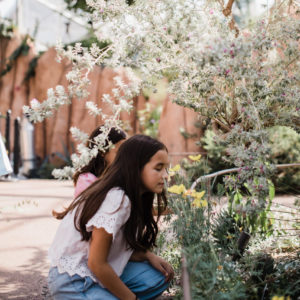
Special Focus: Desert Dome
Plants and animals have adapted to survive in their environment.
Grade Levels: K4-Middle School (program will be adapted for the grade level)
K4-6th Program Information
Description: The desert habitat can be challenging to both plants and animals, and both have developed structures and behaviors that enable them to live in these harsh climates. We will learn the adaptations of some of these desert residents and explore the Desert Dome.
Topics: Life Sciences, Adaptations, Growth and Development, Structure and Function, Interdependent Relationships in Ecosystems, Ecosystems Dynamics, Patterns, Functioning and Resilience, Biodiversity
Applicable Standards
Designed for the Desert explores topics related to the following Wisconsin State Standards:
Life Science K-2
- SCI.LS1.A.1: Structure and Function: All organisms have external parts that they use to perform daily functions.
- SCI.LS1.C.K: Organization for Matter and Energy Flow in Organisms: Animals obtain food they need from plants or other animals. Plants need water and light.
- SCI.LS4.D.2: Biodiversity and Humans: There are many different kinds of living things in any area, and they exist in different places on land and in water.
Physical Science K-2
- SCI.PS3.D.K: Energy in Chemical Processes and Everyday Life: Sunlight warms Earth’s surface
Life Science 3-5
- SCI.LS1.A.4: Structure and Function: Plants and animals have both internal and external macroscopic structures that allow for growth, survival, behavior, and reproduction.
- SCI.LS1.C.5: Organization for Matter and Energy Flow in Organisms: Food provides animals with the materials and energy they need for body repair, growth, warmth, and motion. Plants acquire material for growth chiefly from air, water, and process matter, and obtain energy from sunlight, which is used to maintain conditions necessary for survival.
- SCI.LS2.C.3: Ecosystem Dynamics, Functioning, and Resilience: When the environment changes, some organisms survive and reproduce, some move to new locations, some move into transformed environments, and some die.
- SCI.LS4.C.3: Adaptation: Particular organisms can only survive in particular environments.
- SCI.LS4.D.3: Biodiversity and Humans: Populations of organisms live in a variety of habitats. Change in those habitats affects the organisms living there.
Physical Science 3-5
- SCI.PS3.D.4, 5: Energy in Chemical Processes and Everyday Life: Plants capture energy from sunlight which can be used as fuel or food.
- Stored energy in food or fuel can be converted to usable energy.
Environmental Literacy and Sustainability
6th-9th Program Information
Description: Resources are limited. Organisms fight for different resources. Different resources are limited in different ecosystems (desert vs. tropical limiting factors). Sudden or subtle disruptions in the systems (biotic and abiotic factors) affect those that live there. Organisms must adapt to their environment to survive (survival of the fittest). They pass these traits on to their offspring. This creates biodiversity. Biodiversity is important for humans (think of everything that we use that comes from plants). Plants are critical to our survival, and we should care about the environment!
Topics: Life Sciences, Adaptations, Growth and Development, Structure and Function, Interdependent Relationships in Ecosystems, Ecosystems Dynamics, Patterns, Biodiversity
Applicable Standards
Designed for the Desert explores topics related to the following Wisconsin State Standards:
Life Science MS
- SCI.LS4.C.m: Adaptation: Species can change over time in response to changes in environmental conditions through adaptation by natural selection acting over generations. Traits that support successful survival and reproduction in the new environment become more common.
- SCI.LS1.B.m: Growth and Development of Organisms: Animals (AND PLANTS) engage in behaviors that increase the odds of reproduction. An organism’s growth is affected by both genetic and environmental factors.
- SCI.LS2.A.m Interdependent Relationships in Ecosystems: Organisms and populations are dependent on their environmental interactions both with other living things and with nonliving factors, any of which can limit their growth. Competitive, predatory, and mutually beneficial interactions vary across ecosystems but the patterns are shared.
- SCI.LS2.C.m: Ecosystem Dynamics, Functioning, and Resilience: Ecosystem characteristics vary over time. Disruptions to any part of an ecosystem can lead to shifts in all of its populations. The completeness or integrity of an ecosystem’s biodiversity is often used as a measure of its health.
Earth & Space Science MS
- SCI.ESS2.C.m: The Roles of Water in Earth’s Surface Processes: . . . Water movement causes weathering and erosion, changing landscape features.
Cross Cutting Concepts MS
- SCI.CC1.m: Patterns: Students recognize macroscopic patterns are related to the nature of microscopic and atomic level structure … They use patterns to identify cause and effect relationships.
- SCI.CC7.m: Stability and Change: Students explain stability and change in natural or designed systems by examining changes over time … They understand changes in one part of a system might cause large changes in another part, systems in dynamic equilibrium are stable due to a balance of feedback mechanisms, and stability might be disturbed by either sudden events or gradual changes that accumulate over time.
Science & Engineering Practices MS
- SCI.SEP1.A.m: Asking Questions: Students ask questions to specify relationships between variables and clarify arguments and models. This includes the following: Ask questions that arise from careful observation of phenomena, models, or unexpected results to clarify or seek additional information.
Environmental Literacy and Sustainability
OPTION #3: PLANTS & YOU (K4-9th)
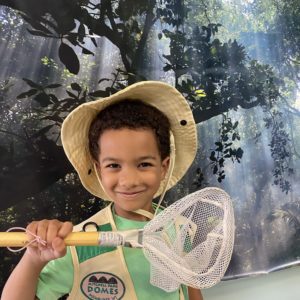
Special Focus: Show Dome
Plants are important to humans, animals and ecosystems in several ways that are vital to our existence.
Grade Levels: K4-Middle School (program will be adapted for the grade level)
K4-6th Program Information
Description: Why are plants so important in our lives? Visit The Domes and experience a better understanding of plants and you! We will explore their uses, dependency, benefits, and live plants up close with a tour of the Show Dome collection.
Topics: Patterns, Asking Questions, Structure and Function, Organization for Matter and Energy Flow in Organisms, Interdependent Relationships in Ecosystems, Systems And System Models
Applicable Standards
Plants & You explores topics related to the following Wisconsin State Standards:
Cross Cutting Concepts K-2
- SCI.CC4.K-2: Systems and System Models: Students understand objects and organisms can be described in terms of their parts and that systems in the natural and designed world have parts that work together.
Science & Engineering Practices K-2
- SCI.SEP1.A.K-2: Asking Questions: Students ask simple descriptive questions that can be tested. This includes the following: Ask questions based on observations to find more information about the natural world. Ask or identify questions that can be answered by an investigation.
Life Science K-2
- SCI.LS1.A.1: Structure and Function: All organisms have external parts that they use to perform daily functions.
- SCI.LS1.C.K: Organization for Matter and Energy Flow in Organisms: Animals obtain food they need from plants or other animals. Plants need water and light.
- SCI.LS2.A.2: Interdependent Relationships in Ecosystems: Plants depend on water and light to grow. Plants depend on animals for pollination or to move their seeds around.
Earth & Space Science K-2
- SCI.ESS2.E.K: Biogeology: Plants and animals can change their local environment.
Cross Cutting Concepts 3-5
- SCI.CC3.3-5: Scale, Proportion, and Quantity: Students recognize natural objects and observable phenomena exist from the very small to the immensely large. They use standard units to measure and describe physical quantities such as mass, time, temperature, and volume.
- SCI.CC4.3-5: Systems and System Models: Students understand a system is a group of related parts that make up a whole and can carry out functions its individual parts cannot. They also describe a system in terms of its components and their interactions.
Science & Engineering Practices 3-5
- SCI.SEP1.A.3-5: Asking Questions: Students ask questions that specify qualitative relationships. This includes the following: Ask questions about what would happen if a variable is changed. Identify scientific (testable) and non-scientific (non-testable) questions. Ask questions that can be investigated and predict reasonable outcomes based on patterns such as cause and effect relationships.
Life Science 3-5
- SCI.LS1.A.4 Structure and Function: Plants and animals have both internal and external macroscopic structures that allow for growth, survival, behavior, and reproduction
- SCI.LS1.C.5: Organization for Matter and Energy Flow in Organisms: Food provides animals with the materials and energy they need for body repair, growth, warmth, and motion. Plants acquire material for growth chiefly from air, water, and process matter, and obtain energy from sunlight, which is used to maintain conditions necessary for survival.
- SCI.LS2.A.5: Interdependent Relationships in Ecosystems: The food of almost any animal can be traced back to plants. Organisms are related in food webs in which some animals eat plants for food and other animals eat the animals that eat plants, while decomposers restore some materials back to the soil.
Environmental Literacy and Sustainability
6th-9th Program Information
Description: Why are plants important? Why do we often overlook them? We’ll discuss some amazing plants that you use everyday and may have changed the course of history! Observe the cells of plants and see what gives them their super powers. Tour The Domes and discover the relationships between plants and both living and nonliving things!
Topics: Life Sciences, Importance of Plants, Structure and Function, Interdependent Relationships in Ecosystems, Ecosystems Dynamics, Patterns, Cause and Effect Relationships
Applicable Standards
Plants & You explores topics related to the following Wisconsin State Standards:
Life Sciences MS
- SCI.LS1.A.m All living things are made up of cells. In organisms, cells work together to form tissues and organs that are specialized for particular body functions.
- SCI.LS1.C.m Plants use the energy from light to make sugars through photosynthesis. Within individual organisms, food is broken down through a series of chemical reactions that rearrange molecules and release energy.
- SCI.LS2.A.m Organisms and populations are dependent on their environmental interactions both with other living things and with nonliving factors, any of which can limit their growth. Competitive, predatory, and mutually beneficial interactions vary across ecosystems but the patterns are shared.
Physical Science MS
- SCI.PS3.D.m Sunlight is captured by plants and used in a chemical reaction to produce sugar molecules for storing this energy. This stored energy can be released by respiration or combustion, which can be reversed by burning those molecules to release energy.
Crosscutting Concepts MS
- SCI.CC2.m Students classify relationships as causal or correlational, and recognize correlation does not necessarily imply causation. They use cause and effect relationships to predict phenomena in natural or designed systems. They also understand that phenomena may have more than one cause, and some cause-and-effect relationships in systems can only be explained using probability.
Environmental Literacy and Sustainability
OPTION #4: DISCOVER THE DOMES (9th-12th)
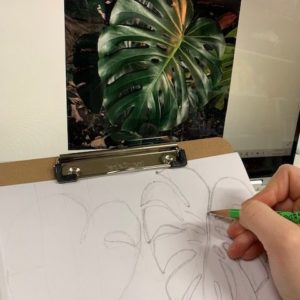
Description: Discover the beauty and wonder of the Mitchell Park Domes by exploring the history and future of one of Milwaukee’s oldest parks. Participants will understand The Domes as a space for gathering information and will be able to apply the information to their everyday lives.
Grade Levels: 9th-12th (program adapted for grade level)
Topics: Ecosystems, Biodiversity, Importance of Plants, Human Impact on the Environment, Environment Impact on Humans, Cycles of Matter and Energy, Structure and Function
Applicable Standards
Discover The Domes explores topics related to the following Next Generation Science and Wisconsin State Standards.
Life Sciences High School
- NGSS HS-LS-1-3: From Molecules to Organisms: Structures and Processes: Plan and conduct an investigation to provide evidence that feedback mechanisms maintain homeostasis
- See also SCI.LS1.A: Structure and Function
- NGSS HS-LS-1-5: From Molecules to Organisms: Structures and Processes: Use a model to illustrate how photosynthesis transforms light energy into stored chemical energy
- See also SCI.LS1.C: Organization for Matter and Energy Flow in Organisms
- NGSS HS-LS-2-4: Ecosystems: Interactions, Energy, and Dynamics: Use mathematical representations to support claims for the cycling of matter and flow of energy among organisms in an ecosystem
- See also: SCI.LS2.B: Cycles of Matter and Energy Transfer in Ecosystems
- NGSS HS-LS-2-5: Ecosystems: Interactions, Energy, and Dynamics: Develop a model to illustrate the role of photosynthesis and cellular respiration in the cycling of carbon among the biosphere, atmosphere, hydrosphere and geosphere
- See also: ESS2.D: Weather and Climate
- NGSS HS-LS-2-2: Ecosystems: Interactions, Energy, and Dynamics: Use mathematical representations to support and revise explanations based on evidence about factors affecting biodiversity and populations in ecosystems of different scales
- See also: SCI.LS2.A: Interdependent Relationships in Ecosystems, SCI.LS2.C: Ecosystem Dynamics, Functioning, and Resilience
- NGSS HS-LS-2-7: Ecosystems: Interactions, Energy, and Dynamics: Design, evaluate, and refine a solution for reducing the impacts of human activities on the environment and biodiversity
- See also: SCI.LS2.C: Ecosystem Dynamics, Functioning, and Resilience, SCI.LS4.D: Biodiversity and Humans
- NGSS HS-LS-4-6: Biological Evolution: Unity and Diversity: Create or revise a simulation to test a solution to mitigate adverse impacts of human activity on biodiversity
- See also: SCI.LS4.C: Adaptation, SCI.LS4.D: Biodiversity and Humans
In-Person Field Trips FAQs

